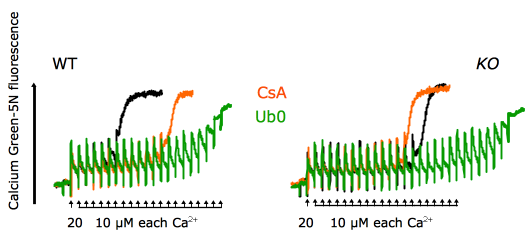Basso Emy
- Details
- Hits: 17605

Research scientist
c/o Complesso Biologico Interdipartimentale
A. Vallisneri
Viale Giuseppe Colombo 3
Padova 35121
Tel 049-8276065
Fax 049-8276040
This email address is being protected from spambots. You need JavaScript enabled to view it.
BACKGROUND
Emy Basso graduated from the University of Padova with a B.S. Degree in Biology in 1994. From the same University she earned a M.S. Degree in Biochemistry and Clinical Chemistry, in 1998. She then went to the Vollum Institute at the Oregon Health & Sciences University for three years of postgraduate research in Molecular Biology. From 2001 until 2011 she worked as staff scientist at the University of Padova. She joined the CNR in December 2011 with a researcher position.
Research summary
Over the years I've been involved in studying mitochondrial physiology, and specifically the occurrence of a sudden increase in permeability of the mitochondrial inner membrane known as permeability transition (PT), which participates in the mechanisms of cell death through the loss of mitochondria membrane potential and the release of proapoptotic molecules. I was involved in the production of a transgenic mouse devoid of the mitochondrial cyclophilin (CypD), contributing in the understanding of the regulation of the permeability transition. The ablation of CyPD has shown that the protein has an important function in regulating PT, thou it is not an essential component of the molecular machinery responsible for the transition (fig 1); moreover it disclosed the role of inorganic phosphate as essentially required for desensitization of PT by Cyclosporin A, or by genetic inactivation of CyPD (Fig 2).
Currently, I'm interested in clarifying the mechanisms that cause mitochondria Ca2+ overload after ischemia and riperfusion of the tissues.
 Fig.1
Fig.1  Fig.2
Fig.2
Representative publications
von Stockum S., Basso E., Petronilli V., Sabatelli P., Forte MA., Bernardi P. (2011). Properties of Ca2+ transport in mitochondria of Drosophila melanogaster, J Biol Chem. 286, 41163-41170
Azzolin L., Basso E., Argenton F., Bernardi P. (2010). Mitochondrial Ca2+ transport and permeability transition in zebrafish (Danio rerio), Biochim Biophys Acta. 1797, 1775-1779
Wang X., Carlsson Y., Basso E., Zhu C., Rousset CI., Rasola A., Johansson BR., Blomgren K., Mallard C., Bernardi P., Forte MA., Hagberg H. (2009). Developmental shift of Cyclophilin D contribution to hypoxic-ischemic brain injury, J. Neurosci. 29, 2588-2596
Basso, E., Petronilli V., Forte M.A., Bernardi P. (2008). Phosphate is essential for inhibition of the mitochondrial permeability tansition pore by Cyclosporin A and Cyclophilin D ablation, Journal of Biol. Chem. 283, 26307-26311
Luvisetto S., Basso E., Petronilli V., Bernardi P., Forte MA. (2008).Enhancement of anxiety, facilitation of avoidance behavior, and occurrence of adult-onset obesity in mice lacking mitochondrial Cyclophilin D, Neuroscience 155, 585-596
Forte MA., Gold BG., Marracci G., Chaudhary P., Basso E., Johnsen D., Yu X., Fowlkes J., Rahder M., Stem K., Bernardi P., Bourdette D. (2007). Cyclophilin D inactivation protects axons in experimetal autoimmune encephalomyelitis, an animal model of multiple sclerosis, Proc. Natl. Acad. Sci. U.S.A 104, 7558-7563
Basso E., Fante L., Fowlkes J., Petronilli V., Forte MA., Bernardi P. (2005). Properties of the permeability transition pore in mitochondria devoid of Cyclophilin D, Journal of Biol. Chem. 280, 18558-18561











